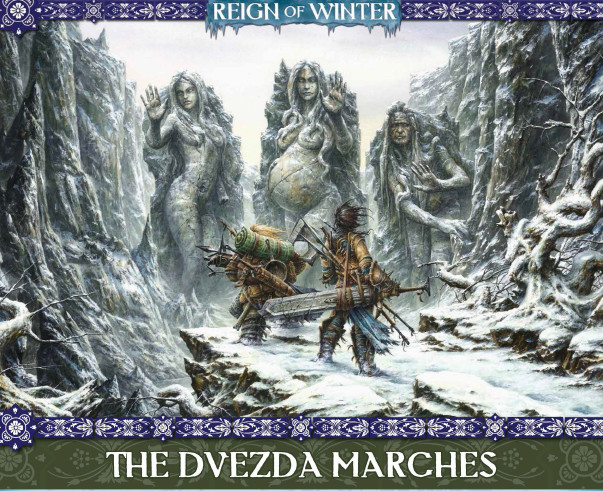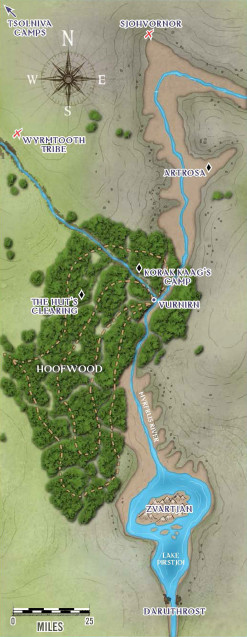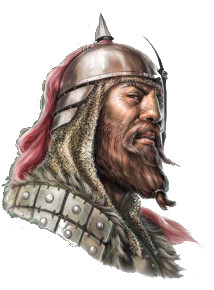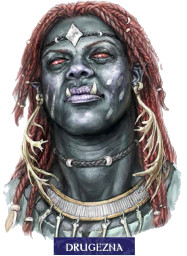« Dvezda Marches » : différence entre les versions
Page créée avec « vignette|droite|Dvezda-marches :''The w1tchwilds, the plague lands, whatever you want to call It! Gods spit on you fools! Anything east of... » |
Aucun résumé des modifications |
||
| Ligne 1 : | Ligne 1 : | ||
[[Fichier:Dvezda-marches.jpg|vignette| | [[Fichier:Dvezda-marches.jpg|upright=2.5|vignette|gauche|Dvezda-marches]] | ||
:''The w1tchwilds, the plague lands, whatever you want to call It! Gods spit on you fools! Anything east of fangard will Only bring you death! Every year 1 get some idiot petitioning The elders’ council for money to fund an expedition east to seek And plunder the ruins of the cyclopes. Every damn year! And for Some reason, this council always sends them! You people always Send them, but ain’t a damn one of them ever comes back!" | :''The w1tchwilds, the plague lands, whatever you want to call It! Gods spit on you fools! Anything east of fangard will Only bring you death! Every year 1 get some idiot petitioning The elders’ council for money to fund an expedition east to seek And plunder the ruins of the cyclopes. Every damn year! And for Some reason, this council always sends them! You people always Send them, but ain’t a damn one of them ever comes back!" | ||
Version du 16 janvier 2017 à 14:59

- The w1tchwilds, the plague lands, whatever you want to call It! Gods spit on you fools! Anything east of fangard will Only bring you death! Every year 1 get some idiot petitioning The elders’ council for money to fund an expedition east to seek And plunder the ruins of the cyclopes. Every damn year! And for Some reason, this council always sends them! You people always Send them, but ain’t a damn one of them ever comes back!"
—oshlak, elder of the orlov1shnaya longhouse, denouncing an Expedition to the dvezda marches
INTRODUCTION
Thave he don't unclaimed have just belongedwilds one to name. no of Iobaria's north single For centu kingdom rieast es, its and quarter lands its denizens have bowed to no king. Some westerners refer to the region as Old Koloran-afer the region's ancient cyclops name. Others call it the Wilds, the Witchwilds (a reference to the statues at Artrosa), or the grimly titled Plague Lands. However, those who make their lives there now call it the Dvezda Marches, afer a group of centaurs who united all the various clans in the region and claimed the whole region as their territory, but who were almost completely wiped out by one of the land's many plagues. The Dvezda were a strong and clever breed ofcentaurs who had a characteristic brindled coat, and to this day, when a centaur is born with brindle markings-a rarity now-he is said to be a Lost Dvezda.
The grassy steppes in the Dvezda Marches support sizable populations of large grazing animals such as aurochs, deer, caribou, and wild horses left behind by human settlers. The lands here remain truly wild, and the chance of seeing another human remains rare. When this occurs, the individual is usually a freigner and fellow treasureseeking adventurer. Rarely, one might come across an abandoned frmstead or small ghost town here. The only other sites of real interest remain the numerous cyclops ruins that dot the land. These consist oftremendous stone structures, toppled, cracked, and overgrown with moss, liverwort, and lichen. While the sight of ruins tempts treasure-seekers, wise travelers have learned to avoid such areas, fr within lie monstrous beasts, bandits, hungry ghosts, and accursed undead cyclopes.
There are no signifcant human settlements in the region, and fiendly fces are fw and fr between. When the plagues swept through the Dvezda Marches, people fled west in mass exodus. Some, however, stayed behind. A number ofpeople were simply too old or infrm to travel, while others wished to stay with their plague-stricken loved ones. Criminals and pariahs also remained in these lands, believing their chances against the plague were better than what they fced back home. Lastly, some who stayed behind were martyrs who thought they could cure the sick, or the madmen who convinced themselves that the entire plague rose out of some sort of conspiracy.
While what happened to these people remains uncertain, small tribes oftheir descendants now wander the eastern steppes. They live nomadic lives, never settling long fr fear of contracting some manner of plague. Tribes in the region remain small; a tribe of more than a hundred is unheard of-even taboo among some-and tribespeople fear congregating in large numbers. They roam about, setting up large animal skin tents each evening, fllowing herd animals and making do with what resources they can scrounge fom the cold and barren lands. Lacking any signifcant bodies of water other than the Myrfus River and scattered streams and ponds, the region receives little rainfll and the soil has turned thin and rocky. These fctors combined with the cold climate have produced a region where frming is nearly impossible. The inhabitants must hunt and travel to survive, chasing the herds, gathering wild tubers and other resilient crops during the warmer seasons, and sometimes preying upon the unwary when they cross paths. Some westerners call these people the plague flk, and shun them as degenerate scavengers.
=Lords of the marches
Centaurs compose the majority of civilized creatures in the region, and they divide themselves into dozens of clans, each claiming its own territory in this harsh land. The centaurs of the area are also separated by ethnicity. The Rashalka centaurs inhabit Hoofwood and the surrounding environs and are generally the most civilized and approachable. The Azorva centaurs are stockier and more muscular, and make their homes in the mountains to the west of the Dvezda Marches. A third ethnicity, the Tsolniva centaurs, lives in the harsh Eastern Ice Steppes, its members bearing thick coats and hairy bodies.
HISTORY

Though present-day life here is grim, evidence ofthe area's ancient civilizations litters the land. The ruins ofmassive stone cities, towering bridges, and great frtressesall remnants of the once-glorious and terrible cyclops civilization ofKoloran-sleep among the steppes like great cold giants. Afer Koloran crumbled, the region factured into chaos while plagues devoured its people.
Swif and terrible, mysterious illnesses struck down thousands. In the end, death and fear drove nearly the entire human population fom these lands. With their exodus, the humans lef behind only sweeping felds of low-yield grasses, tangles of thorny shrubs, and ghost towns. Even in the present day, every human attempt to reclaim the ruins and restore the great cities of the ancients has filed. All have fllen to dark ftes ofwhich even bravest fear to speak. The only civilized creatures in this part oflobaria are the centaurs. The nearest civilized settlement, the port city ofMirnbay, lies over 200 miles to the south on the coast ofthe Castrovin Sea, just west ofthe mouth ofthe Myrfus River.
CLIMATE
The Dvezda Marches have a continental climate with little precipitation. In the most northern regions, winterlike conditions persist nearly year-round. Farther south, the climate turns more hospitable with snows lasting the understory remains scarce, and the hard, rocky soil is slightly acidic and nutrient poor.
Hoofwood provides a home to the Dvezda Marches' sole civilized population-the Rashalka centaurs. The fur most populous centaur clans are Kraask, Phelor, Tsurvom, and Voaldyn. Most of the centaurs fllow the Green Faith, or rather aspects of it, and practice both shamanistic and totemic rites.
With frming nearly impossible in Hoofwood, the centaurs rely on hunting and fraging fr the bulk of their fod. White-headed pheasants sit at the bottom of Hoofwood's fod chain. The birds bring larger predators to the frest as well, such as hoarpanthers and occasionally polar kamadans, both of which the centaurs hunt. Centaur hunters leave no parts oftheir prey unused, and during tribal gatherings various clans fequently trade the cured skins, bones, and teeth ofthese creatures.
Due to their physiology and the lack of steady fod sources, the centaur clans live nomadically fr the most part, traveling the frest along ancestral paths. Each clan keeps its own distinct route. While circumstances (such as pursuing prey or avoiding natural disasters) sometime frce a clan to deviate fom its usual paths, fr the most part the route does not change. During this time, the less than half the year, gracing the region centaurs make numerous stops, with a 4-month growing season. Though it rains little overall, the evaporation rate stays considerably lower than the annual
DVEZDA PLAGUE
Plague appears frequently throughout lobaria. Over the centuries, various diseases have killed thousands, causing the collapse of entire human populations, killing off most of the dragons, and nearly wiping out an entire ethnicity of centaurs. The plague that killed the centaurs came to bear their name, and is known to this day as the Dvezda plague. While most of the centaurs living in the region have established a resistance to this plague, pockets of the virulent contagion still remain a threat to visitors. Anyone traveling through lobaria has a +1% cumulative chance per month of contracting the plague, up to a maximum chance of 12% after 1 year. The Dvezda Plague has the following statistics.
DVEZDA PLAGUE
Type disease, ingested or inhaled; Save Fortitude DC 16
Onset 1d4 days; Frequency 1/day
Effect 1d4 Con damage and 1 Dex damage; Cure 2 consecutive saves
Days after contracting the virus, the victim becomes stricken with a high fever and begins sweating profusely. Later, the victim begins suffering from extreme tremors, followed by a thinning of the blood and bleeding from the tear ducts, nose, ears, and other orifices.
KORAK KAAG

setting up camp in fvored locations or at spots they consider sacred. The most sacred of these stops is Vurnirn, a great centaur settlement built upon the ruins of an ancient cyclops city that lies in the northern part of the frest. rainfll, and therefre enough water remains to sustain plant growth. Still, poor soil quality and permafost in the northern regions limit overall vegetation. Most ofthe Dvezda Marches consists of miles of low, broad steppes flled with wild grasses and low thorny shrubs. The remaining territories include the Eastern Ice Steppes, Deeprun Crevasse, and Hoofwood.
HOOFWOOD
Along the western edge of Deeprun Crevasse stands Hoofwood, a dense boreal frest, composed almost entirely of deciduous conifers. Hoofwood is named fr the dozen or so Rashalka centaur clans that shelter themselves within its frests. The trees in this frestpines and other species of hardy, winter-resistant treesgrow in close-enough proximity that their branches weave together in the canopy, blocking much ofthe sunlight and transfrming the frest floor into a world of shadow and gloom. With little rain and low light, plant growth within Hoofpaths: The centaurs making their homes under the relative safety of Hoofwood's trees learned long ago that staying in one place would only lead to ruin. These creatures live a nomadic life in the frest fllowing fod sources, and over the years this behavior has grown more important to the psyche ofthe centaurs, becoming more than just a survival mechanism. As the various centaur clans make their circuits through Hoofwood, they travel different parts ofthe frest so as not to overlap too much with other clans. The centaurs use the time they spend traveling to pass on oral traditions to young centaurs and build a stronger community through the seasonal recitations of their past. Numerous small holidays, coinciding with phases of the moon, solstices and equinoxes, and locations ofconstellations in the night sky, interrupt the centaurs' hard lives while they make their way along the Hoofpaths each year.
The Hut's Clearing: The Dancin1 Hut of Baba Ya1a always appears in this wide clearing when it visits Iobaria, though this fct is not commonly known. Korak Kaag's Camp: The Voaldyn centaurs fequently camp at this location as they make their traditional circuit ofthe Hoofpaths. Currently, the Voaldyn chieftain Korak Kaag has occupied this site to defnd the northern stretch ofthe Hoofwood fom invaders.
Vurnirn: Humans and other outsiders typically describe Vurnirn as a city of centaurs, yet this defnition lacks accuracy. Vurnirn-or the Centaur's Cliff as it is also called-serves as a centralized location fr holding massive clan gatherings. Throughout the year, centaur clans fom all over Hoofwood travel through Vurnirn to trade goods, exchange news, meet with kin, and fnd spouses. Most nomadic clans stay fr a few weeks, and then, upon wrapping up their business, pack up and move out. Therefre, while Vurnirn seems to have the population of a bustling city, it has fw permanent residents.
Vurnirn also serves as a common ground to discuss political issues between the various tribes. Several times during the year, typically during the summer months unless matters of great importance affect the centaurs, representatives fom the clans that call Hoofwood their territory hold conclaves to discuss important intertribal political issues, settle disputes, and reestablish shared alliances against outside invaders, such as the Tsolniva centaurs who live in the Ice Steppes to the north. Phelor commands most of the political power in southern Hoofwood, while the remaining three tribes-Kraask, Tsurvom, and Voaldyn-share power in central Hoofwood and in the north. Each of the northern clans controls a signifcant section ofVurnirn, and as a show of good will, they take turns hosting Phelor clans whenever the clans make their stopovers.
THE ICE STEPPES
Bordering the Crown of the World, the Ice Steppes are covered in snow year-round. In the warmer months, temperatures rise tojust above feezing. Duringthe winter, when darkness flls fr nearly the entire day, temperatures drop well below feezing and icy blizzards rip through the mountains on a daily basis.
The land is cruel and inhospitable, settled by only the toughest creatures. Dire beasts fom lost ages still roam these wastes, as do tribes ofwolfsh adlets, packs ofpolar kamadans, clutches of fost drakes, tribes of fost and taiga giants, and the most violent and barbaric clans ofthe hirsute Tsolniva centaurs.
Those outside the region remain uncertain ofhow these creatures survive under such extreme conditions, and at frst glance, lif here appears impossible. Ironically, the region's overactive volcanoes have kept these creatures alive. Many lava outpourings cooled over the glaciers that flled the valleys, frming hard stone crusts between the mountains. Once encased in stone, the glaciers have been melted away by the geothermal vents beneath them, leaving behind vast subterranean caverns. The volcanic activity keeps the caverns comfrtably warm year-round while the snow provides ample water. The Tsolniva shelter within these caves in great numbers, as do various giants, trolls, and other beasts.
Tsolniva Camps: The Tsolniva centaur clans may have fund saf and comfrtable homes in the warm caves scattered through the Ice Steppes, but they still lack suffcient fod, leading them to raid their southern cousins. Their harsh lives upon the Ice Steppes has made the Tsolniva ferce and barbaric. Some claim isolated clans have even descended into demon worship. At least one clan of the Tsolniva centaurs has allied with a hunter of both centaurs and giants, a ferce white dragon named Sjohvor.

Wyrmtooth Tribe: Frost giants, bolstered by knowing they live in the lands once controlled by Kostchtchie, remain a great threat to those traveling the Ice Steppes, but another race ofgiants also makes its home here on the rocky tundra-taiga giants. While most taiga giants are nomadic, the Wyrmtooth tribe has remained in the region fr two generations without leaving, putting these giants in conflict over resources with the local fost giants and Tsolniva centaurs-threats the taiga giants manage easily.
Driven here to seek revenge against the white dragon Sjohvor-who attacked an elders' conclave hundreds of years ago, killing halfa dozen influential tribal leadersthe Wyrmtooth giants seek to destroy the dragon and avenge their ancestors. Led by a young charismatic chieftain named Drugezna {CN fmale taiga giant druid 4), the Wyrmtooth clan has yet to gain entrance to Sjohvor's lair, though the giants keep watch on the cave and launch quick reconnaissance missions into its depths when the dragon departs to fed. Drugezna has recently learned that the Tsolniva clan is loyal to Sjohvor, and she plans to erase it fom the Ice Steppes.
DEEPRUN CREVASSE=
Over 3 miles wide in places, the Deeprun Crevasse is a jagged gash torn into the fce of the earth. Flanked on either side by treacherous cliffs, the Myrfus River, also called the Deeprun, crashes through the crevasse floor, winding around a rocky, nearly barren wasteland flled with small crags, snowdrifs, and jagged blocks of ice washed south fom upstream.
The northern stretch ofthe crevasse hosts thick, almost glacial ice on either side ofthe river. Here, hoarfost coats much ofsurrounding area and huge snow drifs pile along the base ofthe cliffwalls, some over 50 fet deep. Farther south, rocky uplifs frm a series ofplateaus that bisect the Deeprun's channel, creating majestic waterflls. The mesas ofArtrosa remain the largest ofthese frmations and partition the southern parts ofthe Crevasse fom the upper crevasse. The area is named afer its most prominent fature, the 3 mile-tall stone statues carved into the precipitous fce ofits highest mesas.
Nearly 30 miles south of Artrosa, the trees of Hoofwood spill over the cliff fce and into the crevasse. Within the shadowed depths ofits great trees, the centaurs have carved stepped trails allowing access to the river below. Beyond, where the frest breaks, the Myrfus emerges fom the trees and pours over a series of rough cliffs. High upon these cliffs nest thousands of bloodhawks, eagles, and other large raptors that swoop down to pluck salmon out of the Myrfus. From the flls, the crevasse continues south, until the cliffs descend into the plain. There, the Myrfus frms a massive circular lake containing an island dotted with huge stone dolmens arranged in a semicircular pattern, their entrances all fcing inward. On the south side of the lake, the river passes beneath the ancient ruined bridge at Daruthrost befre continuing south into the Castrovin Sea.
Artrosa: Built by Baba Yaga almost 2,000 years ago, these massive fgures ofa maiden, mother, and crone watch over the lands once held by Kostchtchie himself Also known as "The Three Who Watch," the fgures represent the stages of womanhood. Each fgure contains a magic-wrought frtress linked to the others by mystic portals. Baba Yaga only inhabited her massive complex fr a short while as she kept watch over the land to ensure Kostchtchie didn't rise up and reclaim the territory he once held. Befre leaving Artrosa, Baba Yaga appointed a warden to see to the place in her absence.
Despite the imposing terrain and treacherous weather conditions, Artrosa remains a desirable destination fr explorers eager to climb the statues and decipher their secrets. Each year, dozens die upon the plateau's freboding slopes, littering the rocky crevices and crannies with their remains. If any have succeeded in unlocking the mystery of these great statues they have yet to share their fndings with the civilized world. More infrmation on Artrosa can be fund in this volume's adventure.
Daruthrost: The dark stones of the towering cyclopean ruins at Daruthrost stand in defance of all natural law. The ruins are best known fr the massive bridge that once spanned the crevasse, destroyed long befre humans visited the area. High above the river, where the apex of the bridge would be, impossibly strong winds scream as ifin agony. Below, the riverbanks on either side ofthe oppressive arch sport piles of sun-bleached bones, while the bridge's heavy shadow stretches outward, painting the surrounding land in gray.
- In the years when humans attempted to settle these eastern lands, they fund the ruins at Daruthrost and moved into the safst of the ancient structures. In the course of a generation, those pioneers transfrmed the encampment fom a small colony into the region's primary trade hub. At its peak, it boasted several budding industries, including a lumber mill, some granaries, a tannery, and dozens of shops. However, a plague swept across the land, and Daruthrost, with its sizable population and constant influx of travelers, provided a veritable breeding ground fr disease. It became known as a plague city, leading to the common saying, "All plagues start in Daruthrost."
Daruthrost was soon cut offfomtrade routes and its people were shunned. Citizens fled by the hundreds, prompting bloody riots and rebellion. The most prominent of these uprisings was led by Kosiavitch Criath, a charismatic sorcerer who led his fllowers to butcher plague victims in order to prevent its spread. The victims then fled to the bridge's upper levels and barricaded them off Criath's fllowers began hollowing out a complex series of living chambers within the bridge. For nearly a decade, they survived in their isolated settlement, but the plagues at last reached them too. Driven by fear, the people turned upon each other again, resorting to gruesome violence. They raced through the settlement, raiding homes in search of anyone with the slightest sign of illness, dragging those they captured to the edge ofthe broken bridge and casting them to their deaths. But the plague continued to spread, and in the end, no one survived. Now the ghosts ofthose who succumbed to the plague and the brutality of their brethren haunt the place.
Sjohvornor: In a cave nested into the side of the crevasse, the great wyrm white dragon Sjohvor claims all of the Dvezda Marches as his personal territory. Fickle and aggressive, this dragon is one of the few of his kind that survived the Drakeplague of 4519 A R . The entrance to his cavernous lair is littered with the remains of dragons he has defeated in combat, a testament to his dislike fr others of his kind and an ample warning that his caves should be left alone. He sees other dragons as competition and delights in fghting with them to reinfrce his power and strength. Sjohvor slumbers much of the time, but periodically he rises and takes to the air, surveying the Dvezda Marches and plucking meals fom the snowy badlands.
Though there are very few humans on whom he can dine, the centaurs of the area make fr satisfying meals-aside fom the Tsolniva centaurs, who have pledged falty to the ancient dragon.
Zvartjan: Worn peaks jut fom an otherwise placid Lake Pirstjoi, frming a series of islands where the Myrfus River pools befre exiting the Deeprun Crevasse. The centaur tribes call these rocky islands Zvartjan and are afaid to visit the place. Few, if any, human explorers have investigated the place thoroughly and returned to tell about it, but the prevailing hypothesis is that this geological feature was where the region's ancient cyclopes quarried some of their stone fr building the many structures and monuments they left behind. The stone in this island's rocky protuberances is very dark and contains flecks of rose-colored quartz. During most of the day, a thick fg clings to the stones and seeps out over the water, and at night strange howls and fightening screams echo across the lake.
Références
<references >/